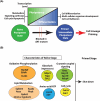The SWI/SNF ATP-dependent chromatin remodeling complex in cell lineage priming and early development
- PMID: 38572912
- PMCID: PMC11088921
- DOI: 10.1042/BST20230416
The SWI/SNF ATP-dependent chromatin remodeling complex in cell lineage priming and early development
Abstract
ATP dependent chromatin remodelers have pivotal roles in transcription, DNA replication and repair, and maintaining genome integrity. SWI/SNF remodelers were first discovered in yeast genetic screens for factors involved in mating type switching or for using alternative energy sources therefore termed SWI/SNF complex (short for SWItch/Sucrose NonFermentable). The SWI/SNF complexes utilize energy from ATP hydrolysis to disrupt histone-DNA interactions and shift, eject, or reposition nucleosomes making the underlying DNA more accessible to specific transcription factors and other regulatory proteins. In development, SWI/SNF orchestrates the precise activation and repression of genes at different stages, safe guards the formation of specific cell lineages and tissues. Dysregulation of SWI/SNF have been implicated in diseases such as cancer, where they can drive uncontrolled cell proliferation and tumor metastasis. Additionally, SWI/SNF defects are associated with neurodevelopmental disorders, leading to disruption of neural development and function. This review offers insights into recent developments regarding the roles of the SWI/SNF complex in pluripotency and cell lineage primining and the approaches that have helped delineate its importance. Understanding these molecular mechanisms is crucial for unraveling the intricate processes governing embryonic stem cell biology and developmental transitions and may potentially apply to human diseases linked to mutations in the SWI/SNF complex.
Keywords: AT-hook; BAF; SWI/SNF; cell fate determination; embryonic stem cells; pluripotency.
© 2024 The Author(s).
Conflict of interest statement
The authors declare that there are no competing interests associated with this manuscript.
Figures


Similar articles
-
Recent insights into the SWI/SNF complex and the molecular mechanism of hSNF5 deficiency in rhabdoid tumors.Cancer Med. 2023 Aug;12(15):16323-16336. doi: 10.1002/cam4.6255. Epub 2023 Jun 14. Cancer Med. 2023. PMID: 37317642 Free PMC article. Review.
-
The AT-hook is an evolutionarily conserved auto-regulatory domain of SWI/SNF required for cell lineage priming.Nat Commun. 2023 Aug 4;14(1):4682. doi: 10.1038/s41467-023-40386-8. Nat Commun. 2023. PMID: 37542049 Free PMC article.
-
BAFfling pathologies: Alterations of BAF complexes in cancer.Cancer Lett. 2018 Apr 10;419:266-279. doi: 10.1016/j.canlet.2018.01.046. Epub 2018 Jan 31. Cancer Lett. 2018. PMID: 29374542 Review.
-
The SWI/SNF ATP-Dependent Chromatin Remodeling Complex in Arabidopsis Responds to Environmental Changes in Temperature-Dependent Manner.Int J Mol Sci. 2020 Jan 23;21(3):762. doi: 10.3390/ijms21030762. Int J Mol Sci. 2020. PMID: 31979421 Free PMC article.
-
Histone H3 tail acetylation modulates ATP-dependent remodeling through multiple mechanisms.Nucleic Acids Res. 2011 Oct;39(19):8378-91. doi: 10.1093/nar/gkr535. Epub 2011 Jul 11. Nucleic Acids Res. 2011. PMID: 21749977 Free PMC article.
Cited by
-
Nuclear Factor I Family Members are Key Transcription Factors Regulating Gene Expression.Mol Cell Proteomics. 2025 Jan;24(1):100890. doi: 10.1016/j.mcpro.2024.100890. Epub 2024 Nov 29. Mol Cell Proteomics. 2025. PMID: 39617063 Free PMC article.
-
Aberrant SWI/SNF Complex Members Are Predominant in Rare Ovarian Malignancies-Therapeutic Vulnerabilities in Treatment-Resistant Subtypes.Cancers (Basel). 2024 Sep 3;16(17):3068. doi: 10.3390/cancers16173068. Cancers (Basel). 2024. PMID: 39272926 Free PMC article. Review.
-
Nonchromatin regulatory functions of the histone variant H2A.B in SWI/SNF genomic deposition.Sci Adv. 2025 Jul 25;11(30):eadx1568. doi: 10.1126/sciadv.adx1568. Epub 2025 Jul 25. Sci Adv. 2025. PMID: 40712016 Free PMC article.
-
RNA Polymerase II Activity Control of Gene Expression and Involvement in Disease.J Mol Biol. 2025 Jan 1;437(1):168770. doi: 10.1016/j.jmb.2024.168770. Epub 2024 Aug 28. J Mol Biol. 2025. PMID: 39214283 Free PMC article. Review.
-
Acetylation-Mediated Epigenetic Consequences for Biological Control and Cancer.Results Probl Cell Differ. 2025;75:25-69. doi: 10.1007/978-3-031-91459-1_2. Results Probl Cell Differ. 2025. PMID: 40593206 Review.
References
Publication types
MeSH terms
Substances
Grants and funding
LinkOut - more resources
Full Text Sources

